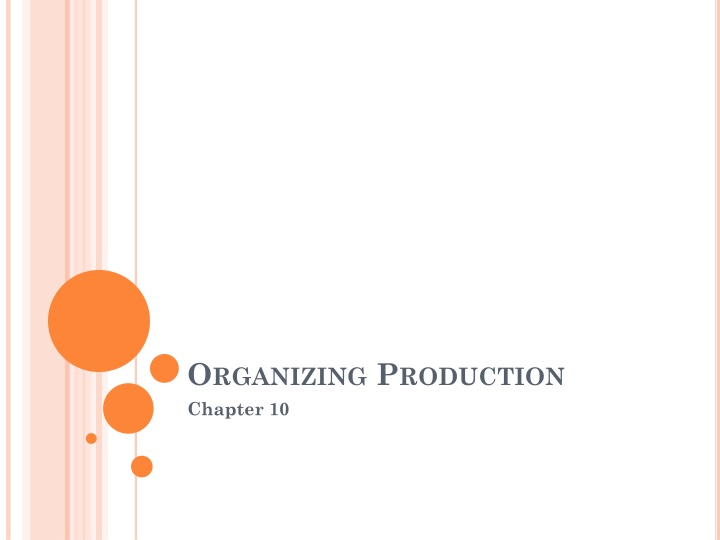
Firm Organization and Profit Maximization in Economics
Explore the concept of firms in economics, their goals of profit maximization, accounting profit vs. economic profit, the principal-agent problem, and different types of markets. Learn how firms are organized and the risks entrepreneurs face when starting a business. Discover the benefits of partnerships and corporations in overcoming business risks.
Download Presentation

Please find below an Image/Link to download the presentation.
The content on the website is provided AS IS for your information and personal use only. It may not be sold, licensed, or shared on other websites without obtaining consent from the author. If you encounter any issues during the download, it is possible that the publisher has removed the file from their server.
You are allowed to download the files provided on this website for personal or commercial use, subject to the condition that they are used lawfully. All files are the property of their respective owners.
The content on the website is provided AS IS for your information and personal use only. It may not be sold, licensed, or shared on other websites without obtaining consent from the author.
E N D
Presentation Transcript
ORGANIZING PRODUCTION Chapter 10
THIS CHAPTER WILL Explain what a firm is and its goal. Explain the difference between accounting profit and economic profit. Define and explain the principal agent problem and describe how firms cope with this problem Describe and distinguish between the types of markets in which firms operate
THE FIRM AND ITS GOAL A firm is an institution that hires factors of production and organizes them to produce and sell goods and services. The Firm s Goal A firm s goal is to maximize profit. If the firm fails to maximize its profit, the firm is either eliminated or taken over by another firm that seeks to maximize profit.
ACCOUNTING PROFIT AND ECONOMIC PROFIT Accounting profits = revenues explicit costs Revenues Explicit costs $400,000 $250,000 wool $80,000 $20,000 $120,000 $5,000 $5,000 $20,000 utilities wages Computer lease Loan interest depreciation Profit $150,000
ACCOUNTING PROFIT AND ECONOMIC PROFIT Revenues Explicit costs $400,000 $250,000 Economic profits = revenues (explicit costs + implicit costs) =Accounting profits-Implicit costs wool $80,000 $20,000 $120,00 utilities wages 0 Computer lease Loan interest depreciation $5,000 $5,000 $20,000 Implicit costs $115,000 Forgone interests Owner s forgone wages Owner s normal profit Economic Profit $15,000 $55,000 $45,000 $35,000
HOW FIRMS ARE ORGANIZED Firms can be organized in any one of five different ways: Single proprietorship Partnership; Corporation; State-owned enterprise (crown corporation); Non-profit organization;
HOW FIRMS ARE ORGANIZED Starting a business is a complicated and risky task. Just two-thirds of new small businesses survive at least two years, and only 44 percent survive at least four years. Most entrepreneurs start their businesses by dipping into their savings, borrowing from the family, and using the founder s credit cards. Getting a bank loan is tough unless you have assets and that often means using your home as collateral. How might a partnership and a corporation help to overcome the risks identified in the news clip?
THE PROBLEM A FIRM MAY FACE The Principal Agent Problem The principal agent problem is the problem of devising compensation rules that induce an agent to act in the best interests of a principal. For example, the stockholders of a firm are the principals and the managers of the firm are their agents.
THE PROBLEM A FIRM MAY FACE AND SOLUTIONS Coping with the Principal Agent Problem Three ways of coping with the principal agent problem are Ownership Long-term contracts Incentive pay
MARKETS AND THE COMPETITIVE ENVIRONMENT Economists identify four market types: 1. Perfect competition 2. Monopolistic competition 3. Oligopoly 4. Monopoly
MARKETS AND THE COMPETITIVE ENVIRONMENT Measures of Concentration Economists use two measures of market concentration: The four-firm concentration ratio: is the percentage of the total industry sales accounted for by the four largest firms in the industry.
THE FOUR FIRM CONCENTRATION RATIO Calculate the four firm concentration ratio for the thingamabob industry; How competitive is the industry according to the ratio? Firm Things R Us ThingMart The Thing Club Thingmania All other firms Sales ($) 500 400 350 250 13,500
HERFINDAHLHIRSCHMAN INDEX The Herfindahl Hirschman index (HHI) is the square of percentage market share of each firm summed over the largest 50 firms in the industry. The larger the measure of market concentration, the less competition that exists in the industry.
THE FOUR FIRM CONCENTRATION RATIO Calculate the HHI for the yadayada industry; How competitive is the industry according to the index? Firm Jerry s Yadayadas Elaine s Yadayadas George s Yadayadas Kramer s Yadayadas Neuman s Yadayadas Sales ($) 30 40 20 5 5
WHY FIRMS Lower transaction costs: costs incurred in making an economic exchange. Economy of scale. Economy of scope. Economy of team production.
